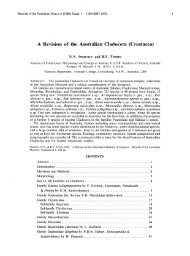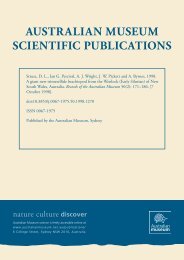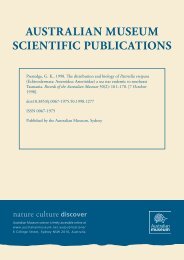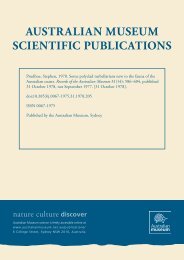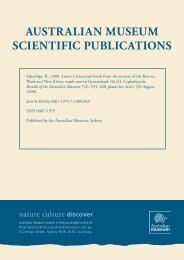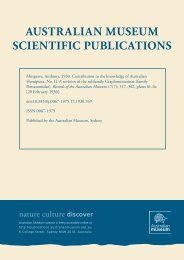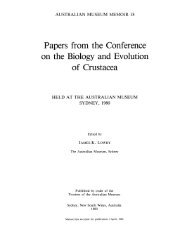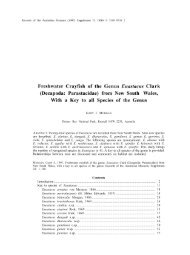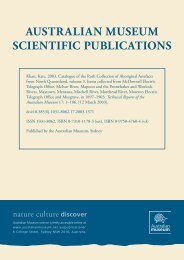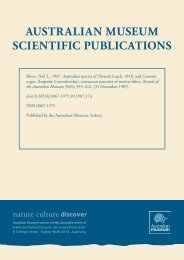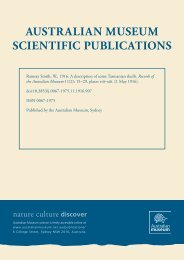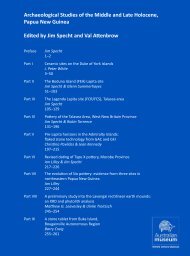Complete work (1212kb PDF) - Australian Museum
Complete work (1212kb PDF) - Australian Museum
Complete work (1212kb PDF) - Australian Museum
You also want an ePaper? Increase the reach of your titles
YUMPU automatically turns print PDFs into web optimized ePapers that Google loves.
7. INTER-RELATIONSHIPS OF RECENT STALKED,<br />
NON-ISOCRINID CRINOIDEA<br />
AILSA M. CLARK<br />
British <strong>Museum</strong> (Natural History), London, England<br />
SUMMARY<br />
Outlines are given of the body form in the extant families of the stalked crinoid orders<br />
Millericrinida and Bourgueticrinida with particular notes on the few taxa exhibiting secondary<br />
arm branching.<br />
The recent nominal species of the Bourgueticrinida are listed in a table, together with their<br />
distributions and an indication of the size range of the often limited known material. The<br />
wisdom of division of these taxa into more than the one family Bathycrinidae is questioned, in<br />
view of recent observations on ontogeny and variation, particularly with regard to the stalk<br />
attachment.<br />
A new record of a particularly relevant species,Porphyrocrinus thalassae Roux, is included,<br />
with a photograph showing the secondary arm branching.<br />
INTRODUCTION<br />
Apart from the aberrant Holopodidae (order Cyrtocrinida), the remammg recent<br />
non-Isocrinid taxa of stalked Crinoidea are referable to two orders - the family Hyocrinidae to<br />
the Millericrinida and the remainder to the Bourgueticrinida. Most of these species are<br />
remarkable among recent crinoids for the conspicuous part the basal plates play in making up<br />
the calyx of the adult.<br />
SYSTEMA TIC ACCOUNT<br />
The Hyocrinidae have thin-walled cup-shaped calyces, surmounted by the arms, which are<br />
more or less widely-spaced, approximately cylindrical in cross-section and un branched in most<br />
genera, includingHyocrinus. However, Calamocrinus diomedae from near the Galapagos Islands,<br />
representative of a monotypic genus, has irregularly-branching arms, evidently formed by<br />
elaboration of up to five of the original pinnules on each side of a primary arm into secondary<br />
arms, themselves bearing pinnules. This kind of augmentation of arm number contrasts with the<br />
multiplication by what is called 'adolescent autotomy' at proximal syzygies followed by<br />
regeneration, with the first new ossicle becoming an axillary, found throughout the Comatulida.<br />
The single exception in this order is Comatula rotalaria Lamarck, from northern Australia, in<br />
which the second brachial of each of the ten primary arms of the post-pentacrinoid gradually<br />
transforms itself into a symmetrical axillary by modification of its appendage into an arm instead<br />
of a pinnule. Similar arm multiplication also occurs in some Isocrinida.<br />
The species of the Bourgueticrinida differ from the Hyocrinidae in having the calyx more<br />
compact and thick-walled, bearing closely approximating arms lacking pinnules on usually the<br />
first six to ten brachials. The nominal species currently recognised are listed in Table 1.<br />
However, some of these names are very likely to prove to be synonymous since many are abyssal<br />
and many are only known from incomplete specimens often of a limited size range, so that<br />
inadequate allowance has often been made for very wide geographical distributions and for<br />
growth changes when naming supposedly new taxa.<br />
The first five genera in Table 1 have been referred to the family Bathycrinidae, three of<br />
them: Rhizocrinus, Conocrinus and Democrinus, having five simple arms while Bathycrinus and<br />
<strong>Australian</strong> <strong>Museum</strong> Memoir No. 16, 1982, 121-128




